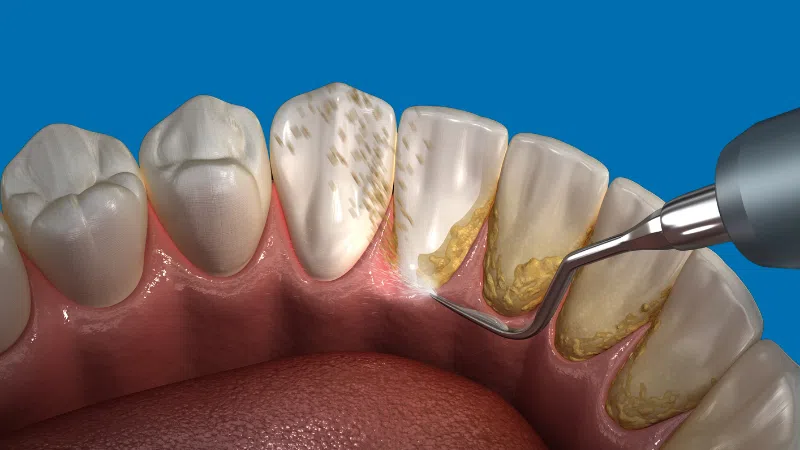Calculus Bridge: Causes, Risks and Treatment


Dental calculus, sometimes called a calculus bridge, is a solid accumulation that develops on teeth due to the accumulation of plaque and tartar. When this accumulation of hardened dental plaque spans over numerous teeth, it forms a "bridge" of calculus. If left untreated, this illness results in significant oral health complications. Approximately 70% of individuals aged 65 and over suffer from periodontal disease, a condition caused mainly by the development of calculus, as stated by the Centres for Disease Control and Prevention.
Plaque is a viscous biofilm of bacteria, saliva, and food debris. Dental plaque develops on the surface of teeth and gums soon after consuming food. Plaque, if not eliminated by thorough brushing and flossing, undergoes a process of hardening and conversion into tartar (or calculus) for 24 to 72 hours.
The procedure operates as follows:
Following food consumption, mainly those high in sugar or starch, microorganisms in the oral cavity consume these particles. As a result, acids are created, which have the potential to harm tooth enamel and create a cohesive coating of plaque.
Tartar forms when plaque on the teeth absorbs minerals from saliva and undergoes a process of hardening. Tartar is far more difficult to eliminate and often requires expert dental cleaning.
Over time, an increasing buildup of plaque and tartar spreads over numerous teeth, resulting in the formation of a calculus bridge.

Dental plaque is composed of bacteria forming on the teeth. It is located at the gumline and is used for dental restorations, including fillings and crowns. The substance has no colour or appears pale yellow and is naturally produced as the bacteria decompose carbohydrates and sugar from the food and fluids taken during the day. If the plaque is not removed from the teeth, it solidifies and becomes calculus. Calculus or tartar combines calcium, bacteria and other organic matter in the oral cavity. While plaque can be removed with routine brushing and flossing, tartar can only be cleaned by expert dental cleanings and procedures. Tartar formation is mainly caused by poor dental hygiene, which means wrong brushing and flossing techniques.
As opposed to plaque, the development of calculus is both substantial and visible, and it varies in colour depending upon its positioning along the gum line. Calculus is generally a solid, moldable compound with yellow above the gum line and dark brown, green, or black below it. The formation of calculus bridges occurs due to the development of plaque on the sides of teeth near the existing bridge, and it begins with a dark band of discolouration at the gumline that invariably expands. However, some variation in development can be observed.
Dry mouth, or xerostomia, is a known risk factor of calculus bridge. Saliva contributes to oral stability by neutralising oral bacteria acidity and ridding the food consumed. It enhances plaque accumulation and calculus forming when saliva is not produced in enough volumes. The reasons for dry mouth are medication, dehydration, and salivary gland diseases.
Inadequate oral hygiene is a prevailing condition generating the formation of a calculus bridge. When teeth are not cleaned and flossed properly, plating occurs on the mouth and gum areas of the teeth. If the plating is not removed within few to several days, it will harden into a substance commonly known as tartar. Consequently, plating leads to the development of a calculus bridge. It is noteworthy that the best preventive measure is to follow an oral hygiene routine regularly.
Regular dental exams are essential for avoiding the development of a calculus bridge. Oral healthcare providers can eliminate plaque and tartar that cannot be effectively addressed with personal dental hygiene practices. Neglecting dental checkups results in the buildup and solidification of plaque, which raises the likelihood of developing tartar and calculus bridges.
Various elements contribute to the creation of a calculus bridge:
A brown or tan line running down the gum line is an evident indication of a calculus bridge. The observed discolouration indicates the existence of calcified tartar.
During the first phases, tartar manifests as pale-yellowish accumulations on the teeth, particularly near the gumline. As these deposits solidify and gather additional plaque and germs, they darken.

Periodontal disease often arises due to calculus bridges, resulting in receding gums. The bacterial infection's development results in the deterioration of connective tissue, causing bone loss and the exposure of tooth roots. Receding gums create spaces between the teeth and gums, which serve as locations for accumulating plaque and calculus.
Halitosis, chronic foul breath, is often indicative of the development of calculus. Unlike common occurrences of "morning breath" or bad breath caused by consuming certain meals, halitosis cannot be eliminated by cleaning teeth, using mouthwash, or consuming mints. It results in periodontal disease, a more severe kind of gum disease.
The bacteria in dental plaque consume the carbohydrates in the oral cavity and release acids as a metabolic waste product. This results in the formation of an acidic environment that causes the degradation of tooth enamel, ultimately resulting in the development of cavities, which are clinically referred to as dental caries.6 Left untreated, cavities lead to discomfort, heightened sensitivity, infection, and, ultimately, tooth loss.
Identifying these signs helps motivate patients to seek expert dental treatment before the problem deteriorates. Regular dental examinations and diligent oral care help avoid more severe dental problems. If a person has symptoms, the Symptom Checker provides basic information, but it is essential to visit a dental expert for a precise diagnosis and treatment.
Gum disease, a bacterial infection of the gums, is the most common result of the formation of calculus. Gingivitis refers to the first phase of gum disease. Gingivitis is primarily characterised by inflammation of the tissues, leading to symptoms such as gum bleeding, redness, and swelling. Gingivitis, which is the first stage of gum disease, may be reversed by consistently practicing good oral hygiene and undergoing comprehensive dental cleanings.
Periodontitis, an advanced form of periodontal disease, is characterised by the formation of interdental pockets between the teeth and gums, which may become infected. If left untreated, this illness leads to the loss of teeth, deterioration of tissues, and degeneration of the jawbone.
To address calculus and mitigate any consequences, it is necessary to have a dentist diagnose the disease. A dentist gathers medical history and does the following diagnostic examinations:
Dentists use dental X-rays to detect and evaluate the presence of calculus accumulation between teeth and at the bottom of gum pockets. This evaluates any damage to teeth or underlying bone.
The dentist evaluates the extent and magnitude of calculus above and immediately below the gum line. In specific applications, compressed air enhances the visibility of deposits.
Dentists use specialised instruments, like probes or a five-pointed explorer, to assess the depth of pockets (the gap between the gum and tooth) and examine them for indications of calculus formation below the gumline.
The main objective in treating calculus bridges is to eliminate the calculus deposits on the teeth, both on the surface and behind the gumline. Available options for treatment encompass:
A professional, thorough cleaning, commonly called scaling, is a frequently used therapy for a calculus bridge. During this operation, a dental hygienist or dentist uses specialised instruments to remove the calcified tartar from the outer layer of the teeth and under the gumline. Scaling effectively eliminates the majority of tartar, minimising the number of germs in the mouth and avoiding more harm to the teeth and gums.

In more severe situations, if the calculus bridge has expanded beyond the gumline, root planing will be required. This process entails refining the root surfaces of the teeth to eliminate any lingering tartar and germs. Root planing facilitates gum reattachment to the teeth, decreasing pocket depth and enhancing healing. Root planing is often performed using local anaesthesia to guarantee the patient's comfort.
According to the CDC article, 29.5% of individuals between the ages of 30 and 44 have been diagnosed with periodontal disease. Seeking competent dental care is essential for treating a calculus bridge. Using sharp instruments or abrasive techniques to remove tartar at home harms the enamel and gums, leading to further difficulties.
Trained dental experts use specialised tools and procedures to safely and efficiently eliminate tartar.
Calculus removal must only be carried out by a dental practitioner certified by a board who works in a dentist's practice. Self-removal of the object with tools is perilous. Dentists are limited to exclusive access to certain areas of the teeth and the ability to avert harm.
After the dentist removes the calculus bridge, teeth become heightened sensitive to cold and heat for a few days. Dental calculus forms a protective layer on teeth that diminishes sensitivity to temperature changes, minimising discomfort caused by heat and cold.
Preventing calculus formation requires adopting good oral hygiene practices to eliminate plaque and hinder the accumulation of germs. Here are some measures a person can take to safeguard teeth:
Ensure that you clean your teeth at least twice daily. Use toothpaste containing fluoride and a toothbrush with soft bristles. Brush your teeth for a minimum of two minutes, covering all areas of your teeth. Position the toothbrush at a 45-degree angle towards the gums and use delicate, circular movements to eliminate plaque efficiently without harming the enamel or gums.
Regular flossing is performed to eliminate plaque and food debris between teeth and the gumline. To clean teeth efficiently, use a delicate sawing motion to manoeuvre the floss between teeth and form it into a C-shape around each tooth.
To optimise efforts in avoiding the creation of dental calculus bridges, it is advisable to utilise a toothpaste that has active components renowned for its ability to battle the accumulation of tartar. Search for:
These substances inhibit the crystallisation of calcium and phosphate on teeth, hence minimising tartar development.
This substance has antimicrobial characteristics and aids in reducing plaque and tartar accumulation.
Incorporate a generous number of fruits, vegetables, healthy grains, and lean proteins into your diet. Fibre-rich foods promote the production of saliva, which serves as a natural mouth cleanser.
The bacteria in the oral cavity flourish on sugars and starches, producing acids that contribute to plaque development—Minimise plaque accumulation by decreasing the consumption of sugary snacks, drinks, and starchy meals.
The absence of food debris and germs helps decrease the probability of plaque and tartar formation. Sugarless chewing gum can facilitate saliva generation and, therefore, helps clean your mouth. More frequent dental appointments can help avoid calculus bridges’ formation. According to the American Dental Association, it is advisable to have dental checkups twice a year to get expert cleanings and timely identification of the problems with your teeth. Further timely action can help you preserve excellent dental health.
Can a calculus bridge lead to tooth loss?
Yes, an untreated calculus bridge often leads to tooth loss. Extensive accumulation and buildup of calculus on the teeth leads to severe gum inflammation and periodontal disease. This chronic infection and inflammation deteriorate the support system of the teeth by involving the gum and bone. With progressive deterioration, the teeth become loose and fall out eventually. Individuals must ensure to clean their teeth at least twice daily. Furthermore, It is crucial to go for regular dental check ups and professional cleanings and scaling to remove the forming calculus and prevent its complications such as periodontal diseases and tooth loss.
What is the role of diet in the formation of a calculus bridge?
Dietary choices and preferences play a significant role in the formation of a calculus bridge. Consuming foods and drinks that are high in sugar and starch can lead to increased buildup of plaque on the teeth. Plaque is a sticky film of bacteria that forms over the teeth when saliva mixes with such food particles. Moreover, diets lacking in essential nutrients also weakens the gums along with deteriorating the overall health, making it easier for the building plaque to accumulate and calcify. It is essential to maintain a balanced diet that is rich in vitamins and minerals and follow good oral hygiene practices to prevent the formation of a calculus bridge.
Dental calculus, sometimes called a calculus bridge, is a solid accumulation that develops on teeth due to the accumulation of plaque and tartar. When this accumulation of hardened dental plaque spans over numerous teeth, it forms a "bridge" of calculus. Plaque, if not eliminated by thorough brushing and flossing, undergoes a process of hardening and conversion into tartar (or calculus) for 24 to 72 hours. Calculus is generally a solid, moldable compound with yellow above the gum line and dark brown, green, or black below it.
Dry mouth enhances plaque accumulation and calculus forming when saliva is not produced in enough volumes. The reasons for dry mouth are medication, dehydration, and salivary gland diseases. Inadequate oral hygiene is a prevailing condition that generates the formation of a calculus bridge. Neglecting dental checkups results in the buildup and solidification of plaque, which raises the likelihood of developing tartar and calculus bridges. Other contributing factors that lead to calculus bridge formation includes hormonal fluctuations during pregnancy, older age, genetic factors, smoking and drinking, diabetes and certain drugs.
The signs of calculus bridge include visible brown or tan tartar over the gum line, whitish and yellowish deposits, receding gums, foul smelling breath, tooth decay and gums inflammation. The main objective in treating calculus bridges is to eliminate the calculus deposits on the teeth, both on the surface and behind the gumline with the help of professional deep cleaning, scaling and root planing.








Plus get the inside scoop on our latest content and updates in our monthly newsletter.